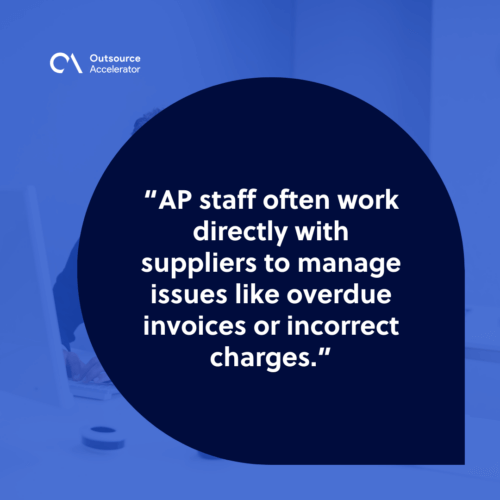8 Essential functions of accounts payable

Managing accounts payable (AP) in a business can be a complex and overwhelming task. Internal AP teams often face challenges such as managing invoices, tracking payments, and maintaining cash flow without costly errors.
A recent PYMENTS study found that 93% of mid-sized businesses still rely on manual processes for their financial operations, despite being aware of its limitations.
As the demands for accuracy and speed grow, many AP teams find it difficult to keep up.
This article will dive into the key functions of AP, highlighting the crucial roles that help streamline operations and improve financial management within organizations.
Definition of accounts payable
Accounts payable (AP) is defined as the money that a company owed to its vendor or suppliers for the products or services that were received. It is considered a short-term liability on the company’s balance sheet.
The AP process involves receiving invoices, verifying their accuracy, and then making payments within agreed terms. Companies can prioritize which bills to pay and maintain financial stability as they keep track of outstanding payments.
Effective management of AP is critical for maintaining strong relationships with vendors, managing cash flow, and avoiding late fees or disruptions in supply. It is an essential function in controlling a company’s finances.

How accounts payable process is done
The accounts payable process often involves four steps to manage and pay invoices accurately:
Invoice capture
It starts with entering invoice details into a system, including vendor information, amounts, and general ledger codes. This step can be prone to human error, especially when data is input manually.
Invoice approval
The AP team reviews the invoice and gets necessary approvals. Often, this means physically circulating the invoice within the office before it can be entered into the company’s system and marked as a cost.
Payment authorization
This is where the team gains approval to pay the invoice. Payment authorization includes the payment method, amount, and timing.
Payment execution
Once authorized, the payment is processed, whether by check, ACH transfer, or credit card. Afterward, remittance details are sent to the vendor, and the invoice is filed and closed out of the system.
This thorough process helps maintain financial control and smooth supplier relationships.
8 Key functions of accounts payable
The AP department is vital in cultivating supplier relationships, tracking expenses, and keeping the company’s finances in check.
Here are eight key functions that shape a well-run accounts payable process.
1. Invoice management
The AP team is responsible for receiving, reviewing, and verifying invoices from suppliers. This process includes confirming that the products or services billed have been delivered and the amounts are correct before proceeding with payment.
2. Data entry
Accurate data entry is highly important. AP personnel manually input invoice details into the system, which includes vendor names, invoice numbers, amounts, and coding. It helps maintain organized financial records.
3. Approval workflow
Before payments are made, invoices typically go through an approval process. The AP team ensures that the appropriate department or manager reviews and authorizes the payment.
4. Vendor communication
Regular communication with vendors is necessary to resolve discrepancies and clarify payment terms. AP staff often work directly with suppliers to manage issues like overdue invoices or incorrect charges.

5. Payment processing
Once an invoice is approved, the AP department processes payments. This could be via check, ACH, or wire transfer, depending on the company’s policy and the vendor’s preference.
6. Payment scheduling
The team schedules payments to avoid late fees while optimizing cash flow. They monitor due dates to ensure that obligations are met on time.
7. Expense tracking
AP tracks all payments made and categorizes them according to the appropriate accounts. This helps keep financial records up to date and accurate for reporting purposes.
8. Reconciliation
Finally, AP works to reconcile payment records with bank statements and internal financial reports. Reconciliation ensures that all transactions align and that no discrepancies exist in the books.
Offshore accounts payable for enhanced internal process
Partner with Clark Staff to optimize your AP department! Focus on strategic activities while your trusted offshore partner handles routine AP tasks like:
- Invoice processing
- Data entry
- Vendor communication
With expertise in offshore AP solutions, Clark Staff can help you scale your operations and improve financial accuracy without the burden of additional overhead.
Contact Clark Staff today to explore how its featured offshoring solutions can benefit your business!







 Independent
Independent




